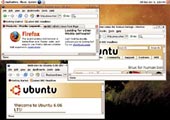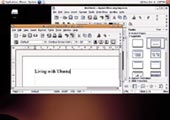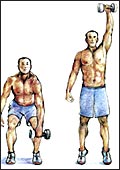 |
|
|
I'm
a great fan of the deadlift. If there's one exercise that works
and impacts almost every large muscle group of your body, it is
the deadlift. If done correctly, the deadlift is an exercise that
works all your back muscles, your quadriceps (front of the thighs),
hamstrings (back of the thighs) and your glutes (butt muscles).
In addition, other muscles involved in stability during the exercise-forearms,
trapezius (the muscle stretching from the neck to the upper back)
and the lats (the sides of your back)-also benefit to some extent.
But the deadlift is a tough exercise to perform. Here's the technique:
Begin by standing with a barbell on the floor in front of you
with your toes under the bar. Now, bend your knees and hold the
bar with both hands in an alternating grip (one palm facing you,
the other facing outward). Your hands should be just outside your
knees. While keeping your back and head straight, stand up. Keep
the bar as close to your body as you can while doing the movement.
Then slowly lower the bar to the starting position.
The downside of the deadlift is that bad
form can cause injury to the spinal column and vertebral discs.
Correct form requires keeping your back flat in its naturally
arched position and your shoulders down through the movement.
While standing up from the starting position you have to ensure
that your hips don't rise up and the bar is as close to your legs
as possible. Imagine forcing your legs through the floor as you
rise up instead of bending your back or using your hips. It's
sensible to use less weight in the beginning to get your form
right before going heavy. A compound movement, which works several
muscle groups, the deadlift is a traditional exercise that is
a part of powerlifting and Olympic competitions but I have always
found it to be a great total body workout.
If you're not sure of your technique, it's
best to avoid deadlifts unless you have a trained supervisor to
oversee your form. But don't lose heart. There's another exercise
that benefits many muscle groups yet is simple to do. It's the
one-arm snatch. Hold a light dumb-bell in one hand and stand with
your feet shoulder-width apart. With your back flat, bend at the
hips and knees similar to the starting position for a deadlift
(i.e., the dumb-bell should be hanging below your knee). See illustration
1. Then, with an explosive movement jump up extending your entire
body so that you are on your toes. While rising, pull the weight
up in front of your body and then fling it overhead without losing
your grip on it. Remember, use the momentum generated by your
jump to move the dumb-bell in one smooth movement. This is one
repetition. Repeat 10 times for each arm. This exercise benefits
both upper and lower body muscle groups, including your shoulders,
legs and back muscles. Start with a relatively light weight to
get your form right and then gradually increase the resistance.
-Muscles
Mani
write to musclesmani@intoday.com
Caveat: The physical exercises described
in Treadmill are not recommendations. Readers should exercise
caution and consult a physician before attempting to follow any
of these.
FIVE
STEPS TO CUT OBESITY
The
world health organization says more than one billion adults around
the world are overweight and 300 million are obese, putting them
at a much higher risk of diabetes, heart problems, high blood
pressure, stroke and some forms of cancer. Women, it says, are
at greater risk.
Measure Yourself: Body Mass Index, or BMI,
is the most common measure of obesity. Mathematically, BMI=Body
weight (in kg.)/height2 (in metre). A person with a BMI of 18.5-24.9
is considered to be of normal weight; a BMI of 25-29.9 means he
is overweight; and a BMI of more than 30, indicates obesity.
Choose Your Diet: Low calorie diets will
help you lose weight. Says Dr Aruna Gaur, Senior Consultant, Holy
Family Hospital, Delhi: "Eat plenty of vegetables, fruits
and grain products. Foods rich in fibre are highly recommended.
Fried foods and fatty desserts are best avoided. Drink water instead
of coffee, tea, or aerated drinks."
Increase Routine Activity: "Incorporate
more physical activity into your day. Start with at least 30-45
minutes of moderate exercise," says Dr Gaur. If you're a
beginner, gradually increase your frequency, duration and intensity.
Ask Your Doctor: A doctor or a health instructor
can help you build a proper, and safe, weight-loss plan. Successful
plans may involve lifestyle and dietary changes for long-term
benefits.
Sleep on Time: Says Dr Gaur: "Set a
regular time for sleep and get at least 7-8 hours of sleep a night.
Avoid watching TV or working from your bed."
-Manu Kaushik
FLOTSAM
Nice Sound, Bad
Price
Apple's boom-box for the iPod is sleek and
simple but is it good value for your money?
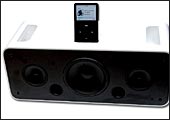 Nearly
eight months after apple launched it, the iPod Hi-Fi is here in
India. It's a white box, sleek and very Apple-esque in its minimalist
design and simple controls, which have come to be the company's
signature for all its products. It's got an iPod dock on top and
comes with eight dock adapters that allow you to play iPods of
any vintage, Minis, Shuffles and Nanos. Pop in your iPod and plug
in the Hi-Fi (it can also be powered by six D batteries) and you're
all set. There's even a tiny remote that controls volume, skips
tracks and switches it on or off. On the box, there are two touch-sensitive
controls-again in true Apple-style minimalism, a '+'and a '-',
for pumping up or dropping down the volume. Nearly
eight months after apple launched it, the iPod Hi-Fi is here in
India. It's a white box, sleek and very Apple-esque in its minimalist
design and simple controls, which have come to be the company's
signature for all its products. It's got an iPod dock on top and
comes with eight dock adapters that allow you to play iPods of
any vintage, Minis, Shuffles and Nanos. Pop in your iPod and plug
in the Hi-Fi (it can also be powered by six D batteries) and you're
all set. There's even a tiny remote that controls volume, skips
tracks and switches it on or off. On the box, there are two touch-sensitive
controls-again in true Apple-style minimalism, a '+'and a '-',
for pumping up or dropping down the volume.
Putting it through the paces was easy. To
kick off, I docked a 40 GB Gen 4. Selected a longish track from
Ominous Seapods' Matinee Idols (1998) and sat back. It's live
Seapods and what better way to check out the Apple box's sound
than a languorous listen to Max Verna's guitar riffs. Verdict:
great treble and mid-range. But the volume needed pumping up for
the sound to fill my quite tiny office room. Then, to check how
it handles bass, I switched to another live recording-Mad maverick
Les Claypool with his Frog Brigade band at Bonnaroo 2002. The
song: Locomotive Breath. Yes, you ageing Tull fans, do check out
Claypool's version. Well, to cut a long track short, the bass
didn't disappoint. Not at all. Nice thumping boom-boxy bass. Sweet.
So why am I not buying the Apple iPod Hi-Fi?
It's the price. It retails at Rs 23,990. Compare that with what
you pay for a 30 GB iPod (Rs 16,700) or even a 80 GB (Rs 23,900).
Plus, for all its sleek simplicity, it weighs in at around 7 kg
and is not portable. And, the sound? Sorry, it's not good enough
to fork out 24K. I'm quite happy with my speakers and amp (with
a dock thrown in) at home, thank you. And while on the move, there
are plenty of third-party sound docks-from the pricey Bose to
the nifty Altec Lansings and JBLS-to choose from. You don't pay
an arm and leg (you do for the Bose, though) and, what's more,
you can pop them into your carryon bag.
P.S. One more crib: What in the world was
Apple thinking when it put a menu button on the remote? Hello,
you folks up there in 'Frisco, what does that button really do?
-SN
Gas Machine
Petrol is expensive. Ergo, carmakers are coming
out with alternatives-like this Liquified Petroleum Gas (LPG)
WagonR from Maruti. So, is it worth it?
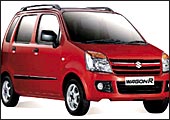 BOOT:
So many good things come at a price. Thanks to the LPG tank, the
spare wheel has been moved up and boot space reduced! BOOT:
So many good things come at a price. Thanks to the LPG tank, the
spare wheel has been moved up and boot space reduced!
FILLER: The gas filler is on the right
side, and LPG costs Rs 29.16 a litre in Delhi; this hurts a lot
less than petrol. Running costs are around Rs 2.50 a km vs Rs
3.50 a km on petrol.
SWITCH: Can't find a gas-station?
No problem; one press of a switch, and the engine does a little
shimmy and you're running on petrol.
ENGINE: Detuned slightly, and feels
a bit sluggish at lower revs, but it gets the job done.
VERDICT: It has next to no luggage
space and LPG stations are few and far between, but it saves Rs
1 per kilometre. If you don't mind paying the Rs 24,000 extra
for the LPG variant-the LXi model costs Rs 3.79 lakh ex-showroom
Delhi-and want an economical runabout, give this a test drive.
-Kushan Mitra
PRINTED
CIRCUIT
Human(e)ly Different?
Not satisfied with going to space, Mark Shuttleworth
wants to make Linux 'human' again.
Ubuntu
is a word derived from the xhosa language and it could be translated
either as "humanity to others" or "I am what I
am because of who we are." Whichever way you look at it,
the word emphasises the role of the community.
After he returned from a week of weightlessness,
Mark Shuttleworth felt that proprietary operating systems were
too expensive and too heavy and that Linux had become too geeky.
Ergo, Ubuntu (or UbuntuLinux) was born.
Ubuntu is a 696 megabyte download, which,
even if you have the highest speeds, will take at least a day
to download from www.ubuntu.com. I downloaded Ubuntu release 6.06
which is the current stable release. The download is in the form
of a 'Live CD' which means you can boot your computer with Ubuntu
without needing to actually install the OS. If you really want
to get the most out of it you will need to have at least 256 MB
of memory. Installing it directly takes up 3 GB of hard-disk space.
However, running Ubuntu from the hard disk
like I did not only keeps the CD drive free, but also means that
the OS runs faster. However, I had a dual-boot system allowing
me to switch back to Windows in case I started having withdrawal
symptoms. If you will run Ubuntu in a networked environment, you
will have to place a 'Help me!' call to your IT admin guys. However,
if you know your settings, you can have Ubuntu up and running
in about 15 minutes. Some problems might occur in a home set-up
if you have a DSL/cable broadband connection, because the connection
software may not be Linux-compatible. Check with your service
provider for details.
The OS already comes with many applications
pre-loaded, both the Firefox browser and OpenOffice are standard
features in a regular Ubuntu download and it also comes with an
Outlook-esque planner and email solution called Evolution. OpenOffice,
which this column has tried earlier, is a smartly packaged free
office suite. Though it is not as capable as MS Office, it's more
than adequate for personal use.
Ubuntu also has the old Linux ace of having
four workspace areas on the desktop, which means you don't have
to clutter all your work into one workplace and all of them are
easily accessible from the bottom right hand corner of the screen.
So for example, while writing this copy and juggling other Office
files, I was surfing the net on another workspace and playing
Solitaire on a third.
In terms of other functionality, Ubuntu comes
with the gimp image editor that is more capable than ms Paint,
the Rhythmbox music player, which has hints of Apple's iTunes
all over it, an audio CD creator (called Serpentine) and some
other toys. But the Linux developer community is quite large and
you can download a fair number of applications, 16,000 of them
to be precise, to make your user experience quite complete.
Working on Ubuntu was a lot easier and far
more pleasant than I really expected. I liked the clean layout
and very easy to use interface. Ubuntu is what it says it is,
a very easy-to-use piece of software, it does not give you more
than you need and it is functional, but infinitely expandable.
For example, there are language packs available for Ubuntu even
in several Indian languages.
Is it a Windows replacement? No, and I don't
think it wants to be one. This is a brilliant solution for first-time
computer users, which I believe is Ubuntu's main target audience-people
who buy low-end computers but want decent functionality.
-Kushan Mitra
|






 N
N BOOT:
So many good things come at a price. Thanks to the LPG tank, the
spare wheel has been moved up and boot space reduced!
BOOT:
So many good things come at a price. Thanks to the LPG tank, the
spare wheel has been moved up and boot space reduced!
